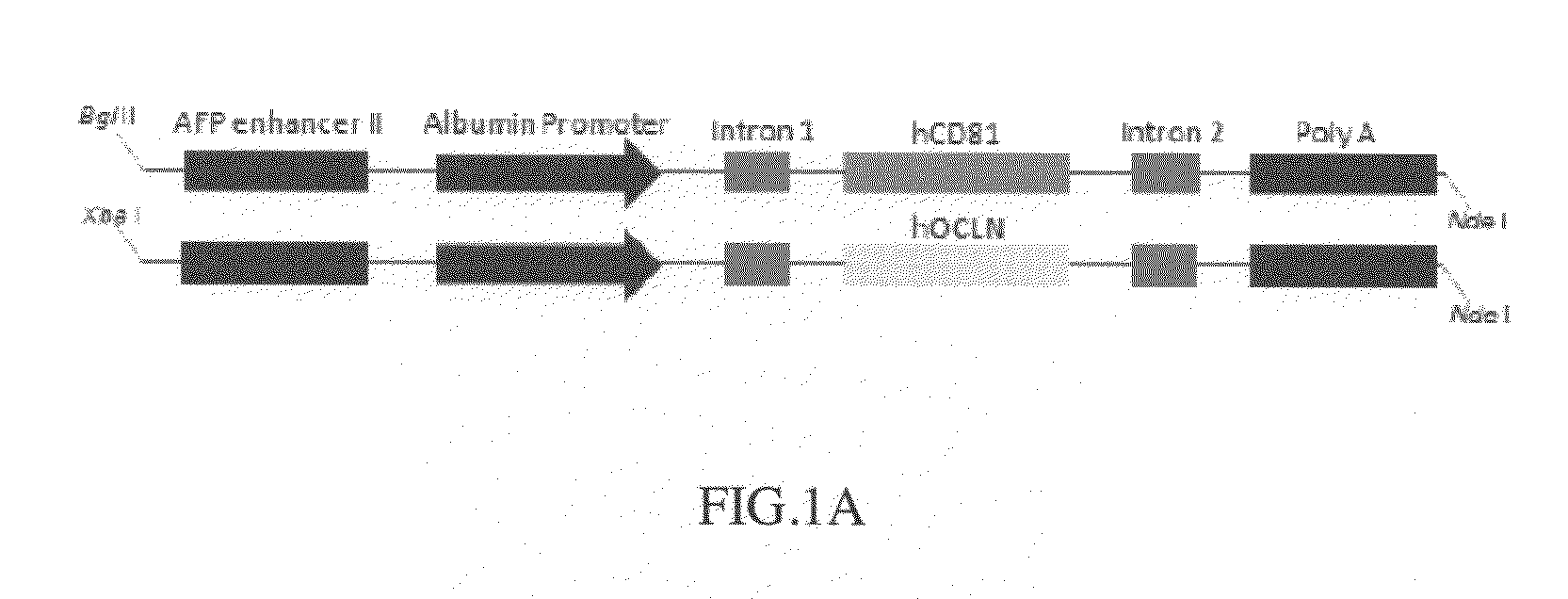Cd81 and ocln double transgenic mouse and its construction methods
a double-transgenic mouse and ocln technology, applied in the field of transgenic technology, can solve the problems of unsuitable long-term research and application, the effect of prevention and treatment of hepatitis c has become a major health issue, and the application is very limited
- Summary
- Abstract
- Description
- Claims
- Application Information
AI Technical Summary
Benefits of technology
Problems solved by technology
Method used
Image
Examples
example 1
Construction of CD81 and OCLN Double Transgenic Mice
[0065]Human CD81 and OCLN cDNA fragments obtained from human cDNA database were PCR amplified with the programmed conditions of the following: 95° C. for 10 minutes; 95° C. for 30 seconds; 58° C. for 30 seconds; 72° C. for 2 minutes; 33 cycles, and then 72° C. for 10 minutes to obtain human CD81 encoding DNA (cDNA) and OCLN encoding DNA (cDNA) respectively (Pfuultra II enzymes were purchased from Agliant company). CD81 cDNA was inserted into a pLIVE® vector in restriction sites between XhoI and BamHI endonuclease to obtain a pLIVE-CD81 vector containing CD81 expression. OCLN DNA (cDNA) was inserted into a pLIVE® vector in restriction sites between SalI and XhoI endonuclease to obtain a pLIVE-OCLN vector containing OCLN expression (endonucleases were purchased from NEB Inc.; pLIVE® vector was purchased from Minis Corporation). The pLIVE-CD81 vectors were excised by BglII and NdeI endonuclease to obtain a linear CD81 DNA fragment (re...
example 2
Construction of HCV Persistent Infection Model
[0066]Plasmid pJ399EM was transcribed in vitro (Han et al., 2009) to obtain a RNA, and then the RNA was electroporated into Huh7.5.1 cells (Pasteur Institute) for virus production during 96 hours and for collection, followed by ultrafiltration and purification to obtain HCV. The C / OTg double transgenic mice or the wile type mice were injected at tail-vein with HCV (TCID50=1×108 / mL) within 1-2 minutes. The serum or liver tissue of the C / OTg double transgenic mice or the wile type mice were collected respectively at indicated time 0 hour to 12 months after infection. HCV RNA level in serum (genomes / mL) and liver (genomes / g) were measured by qRT-PCR. The program was performed as follows: 50° C. for 30 minutes, 95° C. for 10 minutes, followed by 50 cycles at 95° C. for 30 seconds, 58° C. for 30 seconds, and 72° C. for 30 seconds. Primers used for detection were as follows: sense (forward primer): ATCACTCCCCTGTGAGGAACT (represented by SEQ ID ...
example 3
Pharmacodynamic Evaluation of Antiviral Drug in Mice by Acute HCV Infection
[0067]The C / OTg male mice were infected with HCV by tail vein injection (TCID50=1×108) within 1-2 minutes. Starting medical treatment at a week after injection: 20 mg / kg Ribavirin (sigma) administered for 4 weeks by intraperitoneal injection daily or 200 mg / kg, Telaprevir (votex) administered for 2 weeks by intraperitoneal injection daily, wherein the antiviral drug was one component. The serum and liver tissues of the mice were collected after the treatment by Ribavirin for 1 week and 4 weeks, and by Telaprevir for 1 week and 2 weeks. HCV RNA copy numbers in the serum or liver cells were detected by qRT-PCR (Example 2). With respect to the untreated group, the viral copy number in the serum and liver was significantly decreasing after Ribavirin treatment, wherein the viral load in the peripheral blood (genomes / mL) of untreated group was: 123489±5761 (1 week after viral injection), 68312±214 (1 week after int...
PUM
 Login to View More
Login to View More Abstract
Description
Claims
Application Information
 Login to View More
Login to View More - R&D
- Intellectual Property
- Life Sciences
- Materials
- Tech Scout
- Unparalleled Data Quality
- Higher Quality Content
- 60% Fewer Hallucinations
Browse by: Latest US Patents, China's latest patents, Technical Efficacy Thesaurus, Application Domain, Technology Topic, Popular Technical Reports.
© 2025 PatSnap. All rights reserved.Legal|Privacy policy|Modern Slavery Act Transparency Statement|Sitemap|About US| Contact US: help@patsnap.com



